2011 Peugeot 3008 Hybrid 4 trailer
[x] Cancel search: trailerPage 5 of 280

ALPHABETICAL INDEX 266-269
DRIVING 136-155
CHECKS 156-162
PRACTICAL INFORMATION 163-192
TECHNICAL DATA 193-198
AUDIO EQUIPMENT and TELEMATICS 199-265
Electric parking brake.....136Hill start assist................141Head-up display.............144Speed limiter..................r146
Cruise control .................1486-speed electronicgear control gearbox....150Parking sensors ..............154
Bonnet............................157Running out of fuel (Diesel).........................158Diesel engine..................159
Checking levels ..............160Checks............................161
Temporary puncture repair kit .......................163Changing a wheel...........169Changing a bulb.............172Changing a fuse .............17612 V Battery....................183Energy economy mode.............186
Changinga wiper blade ................187Recoveringthe vehicle....................188Towing a trailer...............r189Fitting roof bars ..............190Very cold climate screen..............190Accessories....................191
Electric drive ...................193Diesel engines................194Diesel weights................195
Dimensions .....................196Identification markings....197
VISUAL SEARCH 270-276
Emergency or assistance....199Peugeot Connect Media....203Peugeot Connect Sound ...........................247
Page 24 of 280

22
DRIVING SAFELY
Electric parkin
g brake
Manual application/release
The parking brake can be applied man-
ually
by pulling
the control lever A
.
When the ignition is on, the parking
brake can be released
manually by
pressing the brake pedal
and pulling
then releasing
the control lever A
.
Automatic application/release
Press the accelerator, the parking brake
is released automatically and progres-
sively on acceleration.
When the engine is switched off
, the
parking brake is applied
automatically.
If you get out of your vehicle
with the engine running, apply
the parking brake manually.
Never leave a child alone in the ve-
Before getting out of
the vehicle, check that
the braking warning
lamp ( red!
) and the
warning lamp P
in the control lever A
are on (not fl ashing).
hicle with the ignition on; they could
release the parking brake.
136 If this warning lamp is on in the
instrument panel, the automatic
application/release are deacti-
vated
.
If you are towing a trailer or if
the slope could alter (transport
by ship, lorry, recovery of the
vehicle, ...), make a manual
maximum application of the parking
brake (long pull on the control lever A
)
to immobilise the vehicle.
Page 44 of 280
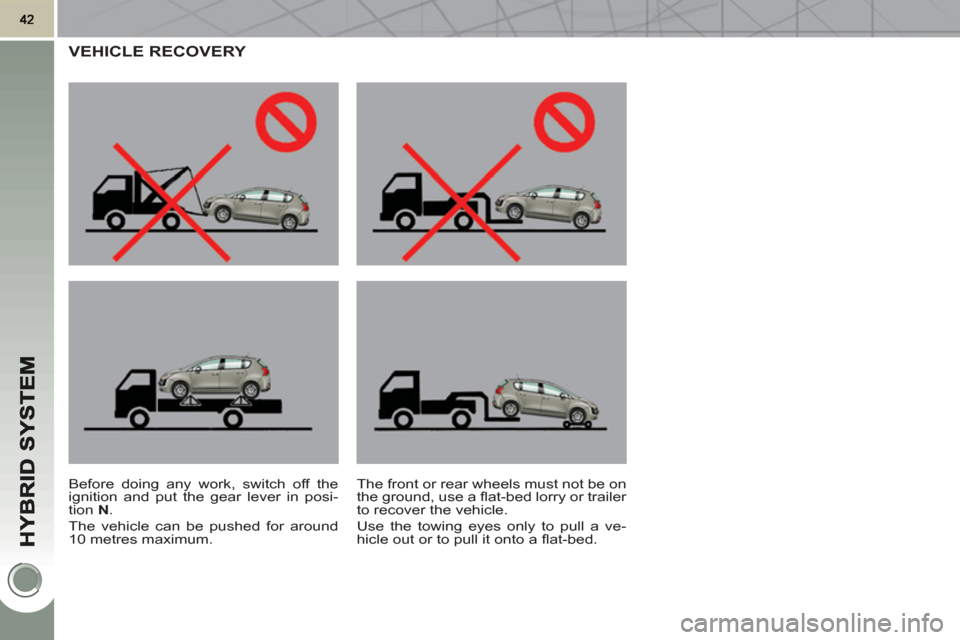
VEHICLE RECOVERY
Before doing any work, switch off the
ignition and put the gear lever in posi-
tion N
.
The vehicle can be pushed for around
10 metres maximum. The front or rear wheels must not be on
the ground, use a fl at-bed lorry or trailer
to recover the vehicle.
Use the towing eyes only to pull a ve-
hicle out or to pull it onto a fl at-bed.
Page 139 of 280

137
With the vehicle stationary, to apply the
parking brake whether the engine is
running or off, pull
on control lever A
.
The application of the parking brake is
confi rmed by:
-
lighting of the braking warn-
ing lamp and of the warning
lamp P
in the control lever A
,
When the driver’s door is opened with
the engine running, there is an audible
signal and a message is displayed if
the parking brake has not been applied,
unless the gear lever is in position P
(Park).
Manual release
With the ignition on or the engine run-
ning, to release the parking brake, press
on the brake
pedal
or the accelerator,
pull then release
control lever A
.
The full application of the parking brake
is confi rmed by:
-
extinction of the braking warn-
ing lamp and of the warning
lamp P
in control lever lever A
,
If you pull control lever A
with-
out pressing the brake pedal,
the parking brake will not be
released and a warning lamp
will come on in the instrument
panel.
Manual applicationMaximum application
If necessary, you can utilise maximum
application
of the parking brake. It is
obtained by means of a long pull
on
control lever A
, until you see the mes-
sage "Handbrake on" and an audible
signal is heard.
In the case of towing, a loaded
vehicle or parking on a gradient,
make a maximum application
of the parking brake then turn the front
wheels towards the pavement and en-
gage a gear when you park.
After a maximum application, the re-
lease time will be longer.
Before leaving the vehicle,
check that parking brake
warning lamp in the instrument
panel is on fi xed, not fl ashing.
Maximum application is essential:
- in the case of a vehicle towing a
caravan or a trailer, if the automatic
functions are activated but you are
applying the parking brake manually,
- when the gradient you are parked
on is variable in its effect (e.g. on a
ferry, in a lorry, during towing),
- display of the message
"Handbrake on".
- display of the message
"Handbrake off".
Page 157 of 280
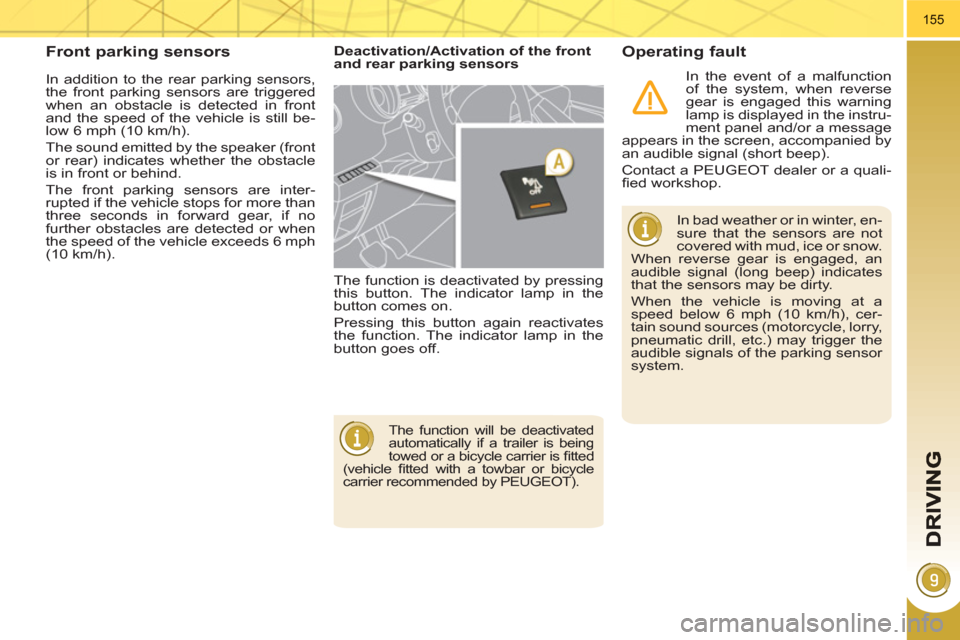
155
In addition to the rear parking sensors,
the front parking sensors are triggered
when an obstacle is detected in front
and the speed of the vehicle is still be-
low 6 mph (10 km/h).
The sound emitted by the speaker (front
or rear) indicates whether the obstacle
is in front or behind.
The front parking sensors are inter-
rupted if the vehicle stops for more than
three seconds in forward gear, if no
further obstacles are detected or when
the speed of the vehicle exceeds 6 mph
(10 km/h).
Front parking sensors
Deactivation/Activation of the front
and rear parking sensors
The function is deactivated by pressing
this button. The indicator lamp in the
button comes on.
Pressing this button again reactivates
the function. The indicator lamp in the
button goes off.
Operating fault
The function will be deactivated
automatically if a trailer is being
towed or a bicycle carrier is fi tted
(vehicle fi tted with a towbar or bicycle
carrier recommended by PEUGEOT).
In bad weather or in winter, en-
sure that the sensors are not
covered with mud, ice or snow.
When reverse gear is engaged, an
audible signal (long beep) indicates
that the sensors may be dirty.
When the vehicle is moving at a
speed below 6 mph (10 km/h), cer-
tain sound sources (motorcycle, lorry,
pneumatic drill, etc.) may trigger the
audible signals of the parking sensor
system.
In the event of a malfunction
of the system, when reverse
gear is engaged this warning
lamp is displayed in the instru-
ment panel and/or a message
appears in the screen, accompanied by
an audible signal (short beep).
Contact a PEUGEOT dealer or a quali-
fi ed workshop.
Page 180 of 280
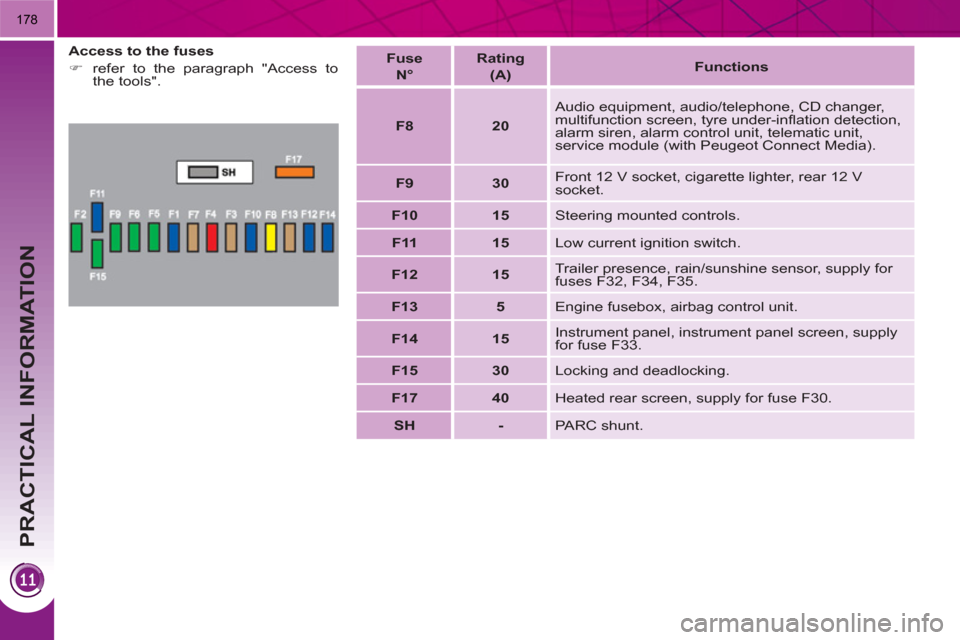
PRACTICAL INFORMATION
178
Access to the fuses
�)
refer to the paragraph "Access to
the tools".
Fuse
N°
Rating
(A)
Functions
F8
20
Audio equipment, audio/telephone, CD changer,
multifunction screen, tyre under-infl ation detection,
alarm siren, alarm control unit, telematic unit,
service module (with Peugeot Connect Media).
F9
30
Front 12 V socket, cigarette lighter, rear 12 V
socket.
F10
15
Steering mounted controls.
F11
15
Low current ignition switch.
F12
15
Trailer presence, rain/sunshine sensor, supply for
fuses F32, F34, F35.
F13
5
Engine fusebox, airbag control unit.
F14
15
Instrument panel, instrument panel screen, supply
for fuse F33.
F15
30
Locking and deadlocking.
F17
40
Heated rear screen, supply for fuse F30.
SH
-
PARC shunt.
Page 181 of 280
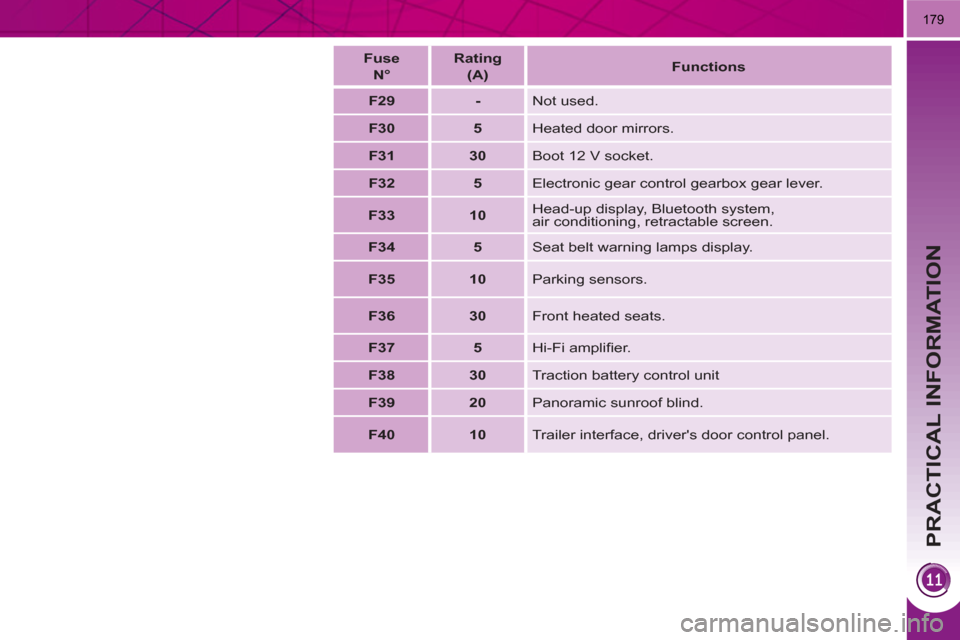
PRACTICAL INFORMATION
179
Fuse
N°
Rating
(A)
Functions
F29
-
Not used.
F30
5
Heated door mirrors.
F31
30
Boot 12 V socket.
F32
5
Electronic gear control gearbox gear lever.
F33
10
Head-up display, Bluetooth system,
air conditioning, retractable screen.
F34
5
Seat belt warning lamps display.
F35
10
Parking sensors.
F36
30
Front heated seats.
F37
5
Hi-Fi amplifi er.
F38
30
Traction battery control unit
F39
20
Panoramic sunroof blind.
F40
10
Trailer interface, driver's door control panel.
Page 184 of 280
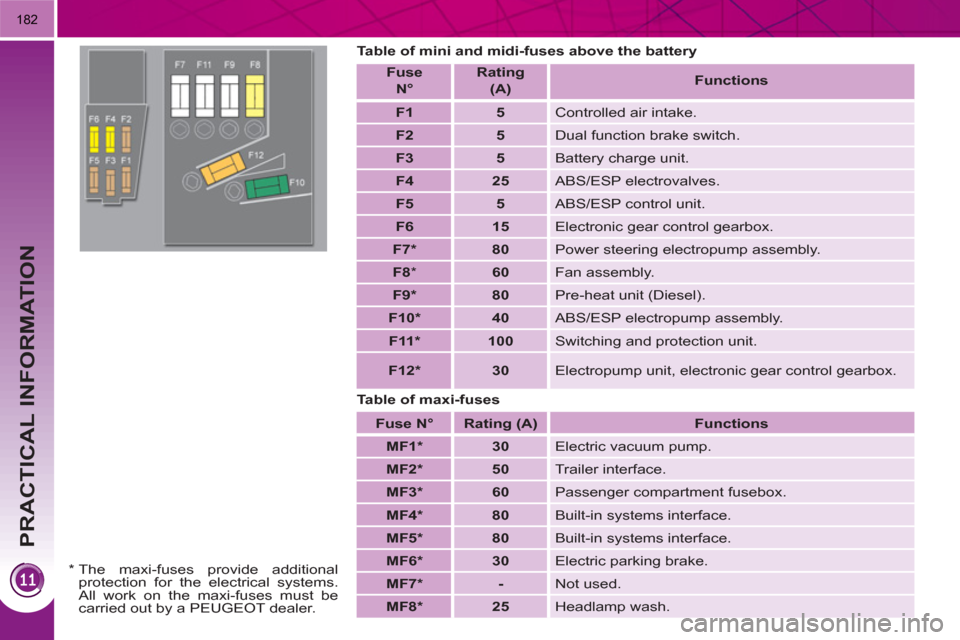
PRACTICAL INFORMATION
182
Table of mini and midi-fuses above the battery
Table of maxi-fuses
Fuse
N°
Rating
(A)
Functions
F1
5
Controlled air intake.
F2
5
Dual function brake switch.
F3
5
Battery charge unit.
F4
25
ABS/ESP electrovalves.
F5
5
ABS/ESP control unit.
F6
15
Electronic gear control gearbox.
F7 *
80
Power steering electropump assembly.
F8
*
60
Fan assembly.
F9 *
80
Pre-heat unit (Diesel).
F10 *
40
ABS/ESP electropump assembly.
F11 *
100
Switching and protection unit.
F12 *
30
Electropump unit, electronic gear control gearbox.
Fuse
N°
Rating (A)
Functions
MF1 *
30
Electric vacuum pump.
MF2 *
50
Trailer interface.
MF3 *
60
Passenger compartment fusebox.
MF4 *
80
Built-in systems interface.
MF5 *
80
Built-in systems interface.
MF6 *
30
Electric parking brake.
MF7 *
-
Not used.
MF8 *
25
Headlamp wash.
*
The maxi-fuses provide additional
protection for the electrical systems.
All work on the maxi-fuses must be
carried out by a PEUGEOT dealer.